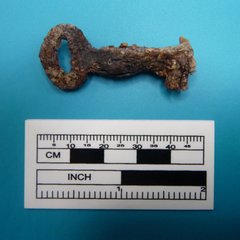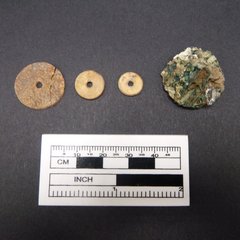This week, we would like to spotlight buttons and a skeleton key found during excavations at the Long Barrack.
Skeleton Key
A skeleton key was recovered from EU-2 at approximately 60 cm below surface. The key is constructed of iron metal and is heavily corroded. Keys of this style were popularized in the 18th and 19th centuries, and were often utilized by locksmiths to unlock multiple types of locks. Although a precise date of the key cannot be determined at this time, archaeologists will examine associated artifacts from this depth to ascertain a more specific time period.
Bone buttons and loop shank button
Three bone buttons (left) and one loop shank button (right) were recovered between 40 and 50 cm below surface within EU-1 and EU-5. Depending on the make and material, buttons are very diagnostic and serve as an excellent dating tool in archaeological settings.
The three bone buttons recovered from excavations contain a single drilled hole, and were likely constructed from cow or pig bone. Plain bone buttons such as these were typically utilitarian and functioned as a fastener for undergarments. Earlier bone buttons were manufactured by hand between the 17th and 18th centuries, and eventually were mass produced by the 19th century.
The loop shank button is constructed of brass or copper, and has an attached loop on the back side. There is no apparent design on the exterior, but was likely enclosed by a decorative fabric or covering. Brass and copper buttons date between the 18th and 19th centuries.




